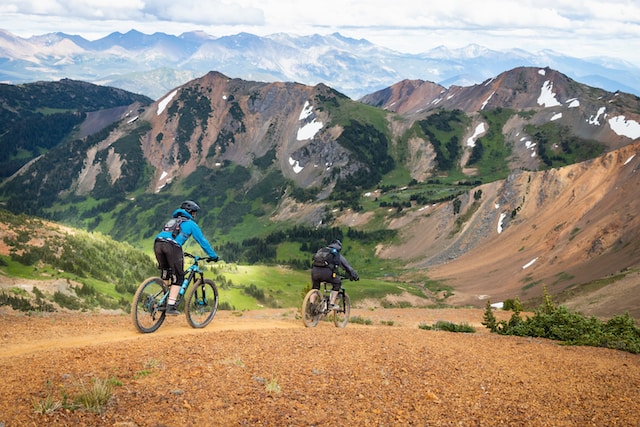Whether you are an experienced mountain biker or new to the sport, take your mountain biking to the next level! Developing your skills to ride technical terrain can significantly increase the enjoyment of your rides.
Cornering
Cornering is one of the most fun aspects of Train to Ride mountain biking training but also one of the most challenging techniques to master. You can use simple tricks to elevate your cornering game and confidently navigate tight twists and turns. Start by focusing on your body position. Instead of leaning your whole body into the corner, try pointing your core in your desired direction.
Consciously shifting your hips or chest will help you turn the bike more effectively. Braking smoothly and progressively before the corner will also help you maintain speed and control. Finally, remember to take the inside line of the corner (outside-inside-outside technique) to make it faster. This allows you to drive into the trail and maximize traction.
Climbing
Climbing is a crucial skill for mountain bikers. It can differ between riding to your potential or walking the bike up steep climbs. There are two types of climbing: short, steep climbs with obstacles that require a high effort for a short period and long, gradual climbs where it’s essential to maintain a steady pace. A rider should remain seated during long, gradual climbs to minimize effort.
A good seat position is neutral, with a slight bend in the elbows to absorb the terrain. A rider should also practice shifting weight forward and backward on the bike. Riders moving too far forward can lose traction on the rear wheel and spin out. Also, experimenting with different tire pressures can make a massive difference for smoother rides.
Stability
Stability must be a part of your Motocross Workout Plan and is essential to maintain control when navigating challenging terrain or transitions on your mountain bike. You can increase your stability by correctly positioning your body and absorbing obstacles’ impact with your arms and legs.
When maneuvering through turns and berms, shift your body weight to the outside pedal. This will lower your center of gravity, enhance traction, and improve stability. Similarly, keep your elbows and knees bent to absorb the impact of obstacles.
Speed
Pedaling efficiently, applying pressure correctly, and learning to control your body’s positioning can help you reach and maintain top speeds on challenging terrain. This is a crucial skill that mountain bikers of all levels should master, regardless of discipline. For example, a seasoned rider will shift their weight dynamically to make it easier to pedal over an obstacle without stopping.
This can save energy and prevent toppling over, even when the terrain gets rough. Similarly, riders can learn to pop wheelies to add flair and style to their riding. This requires a precise body position, arm strength, and pedal power balance. Once mastered, this skill will impress trail companions and spectators alike! You can also use this technique to soar through downhill jumps and gain confidence on challenging descents.
Control
Keeping a firm grip on your speed is crucial to mountain biking. This skill allows you to control your bike precisely and efficiently through trail sections. It also helps you climb steep gradients more quickly, descend faster, and ride in adverse weather conditions. One of the most complex skills to learn is controlling your instincts when facing a perceived danger.
Many riders are tempted to lean away from an obstacle, which makes them more unstable and increases the likelihood of a crash. By practicing, you can retrain your instincts and stay in the hinged position that gives you more excellent stability. Similarly, using the Row and Anti-Row movement patterns when riding berms will allow you to carry more speed through turns. This is especially important when tackling rocky or technical sections of the trail.
